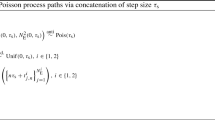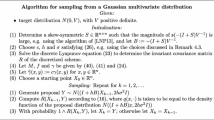Abstract
Because so many random processes arising in stochastic geometry are quite intractable to analysis, simulation is an important part of the stochastic geometry toolkit. Typically, a Markov point process such as the area-interaction point process is simulated (approximately) as the long-run equilibrium distribution of a (usually reversible) Markov chain such as a spatial birth-and-death process. This is a useful method, but it can be very hard to be precise about the length of simulation required to ensure that the long-run approximation is good. The splendid idea of Propp and Wilson [17] suggests a way forward: they propose a coupling method which delivers exact simulation of equilibrium distributions of (finite-state-space) Markov chains. In this paper their idea is extended to deal with perfect simulation of attractive area-interaction point processes in bounded windows. A simple modification of the basic algorithm is described which provides perfect simulation of the repulsive case as well (which being nonmonotonic might have been thought out of reach). Results from simulations using a C computer program are reported; these confirm the practicality of this approach in both attractive and repulsive cases. The paper concludes by mentioning other point processes which can be simulated perfectly in this way, and by speculating on useful future directions of research. Clearly workers in stochastic geometry should now seek wherever possible to incorporate the Propp and Wilson idea in their simulation algorithms.
Access this chapter
Tax calculation will be finalised at checkout
Purchases are for personal use only
Preview
Unable to display preview. Download preview PDF.
Similar content being viewed by others
References
Baddeley, A. J. and van Lieshout, M. N. M. (1995). Area-interaction point processes. Ann. Inst Statist Math. 47, 601–619.
Ben Arous, G., Cranston, M. and Kendall, W. S. (1995). Coupling constructions for hypoelliptic diffusions: Two examples. In Stochastic Analysis: Summer Research Institute July 11-30, 1993. ed. M. Cranston and M. Pinsky. vol. 57. American Mathematical Society, Providence, RI. pp. 193–212.
Besag, J. and Green, P. J. (1993). Spatial statistics and Bayesian computation (with discussion). J. Roy. Statist. Soc. 55, 25–37.
Chayes, J. T., Chayes, L. and Kotecký, R. (1995). The analysis of the Widom-Rowlinson model by stochastic geometric methods. Comm. Math. Phys. 172, 551–569.
Chen, M.-F. (1994). Optimal couplings and application to Riemannian geometry. In Probability Theory and Mathematical Statistics, ed. B. Grigelionis et al. vol. 1. VPS/TEV. p. 15.
Darling, R. W. R. (1987). Constructing Nonhomeomorphic Stochastic Flows, vol. 376. American Mathematical Society. Providence, RI.
Dufresne, D. (1991). The distribution of a perpetuity, with applications to risk theory and pension funding. Scand. Actuarial J.39–79.
Garey, M. R. and Johnson, D. S. (1979). Computers and Intractability: A Guide to the Theory of NP-completeness. Freeman, San Francisco, CA.
GeorgII, H.-O. AND Küneth, T. (1996). Stochastic comparison of point random fields, (submitted).
Kendall, W. S. (1986). Nonnegative Ricci curvature and the Brownian coupling property. Stochastics 19, 111–129.
Letac, G. (1986). A contraction principle for certain Markov chains and its applications. In Random Matrices and their Applications, ed. J. Cohen, H. Kesten, and C. Newman, vol. 50. pp. 263–273.
Lindvall, T. (1982). On coupling of Brownian motions. Technical report. University of Göteborg Department of Mathematics, Chalmers University of Technology & University of Göteborg.
Lotwick, H. W. and Silverman, B. W. (1981). Convergence of spatial birth-and-death processes. Math. Proc. Camb. Phil. Soc. 90, 155–165.
Møller, J. (1989). On the rate of convergence of spatial birth-and-death processes. Ann. Inst. Statist. Math. 41, 565–581.
Preston, C. J. (1976). Random Fields, vol. 534 of Springer Lecture Notes in Mathematics. Springer, Berlin.
Preston, C. J. (1977). Spatial birth-and-death processes. Bull. Inst. Int. Statist 46(2), 371–391.
Propp, J. G. and Wilson, D. B. (1996). Exact sampling with coupled markov chains and applications to statistical mechanics. Random Structures and Algorithms 9, 223–252.
Ripley, B. D. (1977). Modelling spatial patterns (with discussion). J. Roy. Statist. Soc. 39, 172–212.
Ripley, B. D. (1979). Simulating spatial patterns: dependent samples from a multivariate density. Appl. Statist. 28, 109–112.
Stoyan, D., Kendall, W. S. and Mecke, J. (1995). Stochastic Geometry and its Applications. 2nd edn. Wiley, Chichester.
Widom, B. and Rowlinson, J. S. (1970). New model for the study of liquid-vapor phase transitions. J. Ghem. Phys. 52, 1670–1684.
Author information
Authors and Affiliations
Editor information
Editors and Affiliations
Rights and permissions
Copyright information
© 1998 Springer-Verlag New York, Inc.
About this chapter
Cite this chapter
Kendall, W.S. (1998). Perfect Simulation for the Area-Interaction Point Process. In: Accardi, L., Heyde, C.C. (eds) Probability Towards 2000. Lecture Notes in Statistics, vol 128. Springer, New York, NY. https://doi.org/10.1007/978-1-4612-2224-8_13
Download citation
DOI: https://doi.org/10.1007/978-1-4612-2224-8_13
Publisher Name: Springer, New York, NY
Print ISBN: 978-0-387-98458-2
Online ISBN: 978-1-4612-2224-8
eBook Packages: Springer Book Archive




